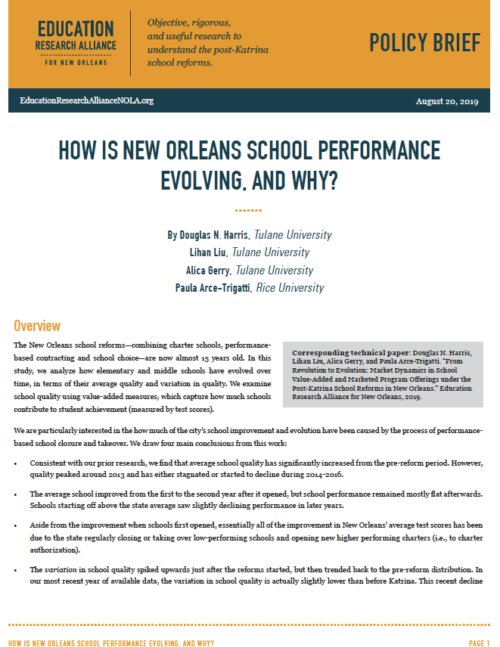How is New Orleans School Performance Evolving, and Why?
A new study by Douglas N. Harris, Lihan Liu, Alica Gerry, and Paula Arce-Trigatti examines how school quality and program offerings are changing in New Orleans.

How is New Orleans School Performance Evolving, and Why?
Published
by Douglas N. Harris, Lihan Liu, Alica Gerry, Paula Arce-Trigatti
The New Orleans school reforms — combining charter schools, performance-based contracting and school choice — are now almost 15 years old. In this study, we analyze how elementary and middle schools have evolved over time, in terms of their average quality and variation in quality. We examine school quality using value-added measures, which capture how much schools contribute to student achievement (measured by test scores). We are particularly interested in the how much of the city’s school improvement and evolution have been caused by the process of performance-based school closure and takeover. We draw four main conclusions from this work: Consistent with our prior research, we find that average school quality has significantly increased from the pre-reform period. However, quality peaked around 2013 and has either stagnated or started to decline during 2014 – 2016. The average school improved from the first to the second year after it opened, but school performance remained mostly flat afterwards. Schools starting off above the state average saw slightly declining performance in later years. Aside from the improvement when schools first opened, essentially all of the improvement in New Orleans’ average test scores has been due to the state regularly closing or taking over low-performing schools and opening new higher performing charters (i.e., to charter authorization). The variationin school quality spiked upwards just after the reforms started, but then trended back to the pre-reform distribution. In our most recent year of available data, the variation in school quality is actually slightly lower than before Katrina. This recent decline in quality variation is also mostly due to the school closure/takeover process. Eliminating the lowest-performing schools increased the average school quality and reduced variation. Schools’ contributions to student achievement, or value-added, is not the only way to look at schools. For example, we briefly analyze the number of and variation in program options available (e.g., extracurricular activities) after the reforms started. These results suggest that the average number of extracurricular activities advertised by schools increased during the post-reform period, along with, to some degree, the variation in schooling options. There are two general ways to improve school quality. First, existing schools may improve through internal efforts and with the support, programs, and policies of school districts and other governmental and non-governmental agencies. Second, since it sometimes may be difficult to improve schools from within and with existing personnel, we can also start over — by closing schools and moving students to other schools, or by taking over low-performing schools and turning control over to other groups of educators. Our analysis suggests there is still room for New Orleans schools to improve through both of these mechanisms. The performance of new schools continues to be higher than schools that have closed or been taken over. However, the impacts of such extreme measures will very likely be smaller than in the past. Closure and takeover alone cannot produce a high-quality education system.
Related Publications
Can Text Messages Help Families Applying for Early Childhood Education Programs?
Apr 15, 2019 | by Lindsay Weixler, Jon Valant, Daphna Bassok, Justin B. Doromal, Alica Gerry
New Orleans Student Commute Times by Car, Public Transit, and School Bus
Sep 27, 2018 | by Jane Arnold Lincove, Jon Valant
How Has the Louisiana Scholarship Program Affected Students? A Comprehensive Summary of Effects after Three Years
Jun 26, 2017 | by Jonathan N. Mills, Patrick J. Wolf

